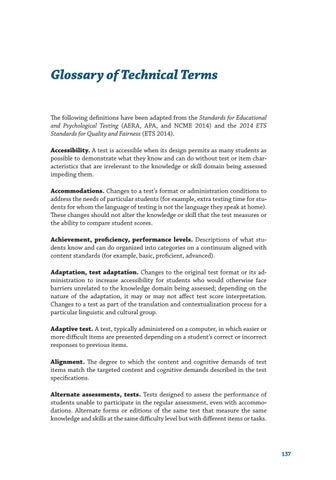Glossary of Technical Terms The following definitions have been adapted from the Standards for Educational and Psychological Testing (AERA, APA, and NCME 2014) and the 2014 ETS Standards for Quality and Fairness (ETS 2014). Accessibility. A test is accessible when its design permits as many students as possible to demonstrate what they know and can do without test or item characteristics that are irrelevant to the knowledge or skill domain being assessed impeding them. Accommodations. Changes to a test’s format or administration conditions to address the needs of particular students (for example, extra testing time for students for whom the language of testing is not the language they speak at home). These changes should not alter the knowledge or skill that the test measures or the ability to compare student scores. Achievement, proficiency, performance levels. Descriptions of what students know and can do organized into categories on a continuum aligned with content standards (for example, basic, proficient, advanced). Adaptation, test adaptation. Changes to the original test format or its administration to increase accessibility for students who would otherwise face barriers unrelated to the knowledge domain being assessed; depending on the nature of the adaptation, it may or may not affect test score interpretation. Changes to a test as part of the translation and contextualization process for a particular linguistic and cultural group. Adaptive test. A test, typically administered on a computer, in which easier or more difficult items are presented depending on a student’s correct or incorrect responses to previous items. Alignment. The degree to which the content and cognitive demands of test items match the targeted content and cognitive demands described in the test specifications. Alternate assessments, tests. Tests designed to assess the performance of students unable to participate in the regular assessment, even with accommodations. Alternate forms or editions of the same test that measure the same knowledge and skills at the same difficulty level but with different items or tasks.
137

